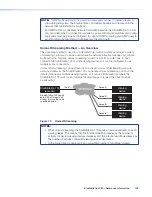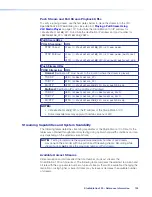
StudioStation 100 • Reference Information
97
5.
The main DataViewer dialog box opens and the StudioStation 100 responds with a
copyright statement containing the model number, part number, and current firmware
version of the connected StudioStation 100, along with the date (see figure 71,
2
).
1
2
3
4
Figure 71.
Enter Commands and View Responses
6.
Use the
Commands
field to enter SIS commands (
1
). View the responses in the
Responses
field (
2
).
For example, enter
1I
, the command to display the model name, in the
Commands:
field (
3
). The
Responses:
field (
4
) returns the model number of the connected
device.
What is an IP Address?
A full explanation of IP addressing is beyond the scope of this user guide. However, the
following information is enough to get started.
An IP address is a 32‑bit binary number that is used to identify each device on an Ethernet
network. This number is usually represented by four decimal numbers (each in the
range
0
to 255) separated by dots, (for example,
198.123.34.240
). This is called
"dotted decimal notation".
An IP address is divided into two parts:
•
The network identifier
•
The host identifier
On a given network, each address must have the same network identifier value, but have a
unique host identifier. There are, therefore, different classes of addresses that define:
•
The range of valid addresses.
•
The parts of the address used to identify the network and host.
The most common IP address classes are:
Class
Valid Address Range
Identifier Arrangement
Class A
0.0.0.1
to
127.255.255.254
NNN.HHH.HHH.HHH
Class B
128.0.0.1
through
191.255.255.254
NNN.NNN.HHH.HHH
Class C
192.0.0.1
through
223.255.255.254
NNN.NNN.NNN.HHH
NOTES:
•
NNN
= Network identifier
•
HHH
= Host identifier
figure 71






























